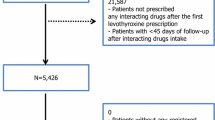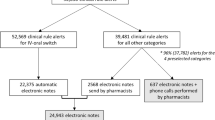Abstract
Objective. Many drugs are known to affect the results of laboratory tests. This may cause problems in the interpretation of clinical laboratory data and lead to wrong diagnoses, unnecessary further tests and additional costs. A computerized monitoring system of potential drug effects on laboratory tests was developed in Turku University Central Hospital. In the present study the incidence and nature of potentially interfering drug effects in thyroid function diagnostics was examined in order to ease the clinical implementation of the system. Methods. Computerized medication data of 754 hospital in-patients whose thyroid function was tested were combined with a knowledge base of drug effects on laboratory tests. All medications that potentially affected the levels of serum thyrotropin or free thyroxin in study patients were detected. Results. 40% (292 of 735) of the patients tested for thyrotropin and 32% (107 of 333) of the patients tested for free thyroxin received potentially interfering medication during the tests. The most common potentially interfering medication was acetylsalicylic acid, but the daily dose was usually low, 100 mg. Conclusions. The coincidence of potentially interfering medication and thyroid function tests was substantial. On-line hints of drug effects on thyroid function tests might offer valuable decision support to clinicians, but further development of the system is needed to regulate the prevalence of warnings into a clinically optimal level.
Similar content being viewed by others
Abbreviations
- ATC:
-
Anatomic Therapeutic Chemical
- DLI:
-
Drug Laboratory Interference/Interaction
- IFCC:
-
International Federation of Clinical Chemistry
References
Young DS, Thomas DW, Friedman RB, Pestaner LC. Effects of drugs on clinical laboratory tests. Clin Chem 1972; 18: 1041–1303
Young DS. Effects of Drugs on Clinical Laboratory Tests. 4th ed. Washington: AACC Press, 1995
Grönroos P, Irjala K, Heiskanen J, Torniainen K, Forsström JJ. Using computerized individual medication data to detect drug effects on clinical laboratory tests. Scand J Clin Lab Invest 1995; 55 (222 Suppl): 31–6
Grönroos P, Irjala K, Forsström JJ. Coding drug effects on laboratory tests for health care information systems. Proc Annu Symp Comput Appl Med Care 1995: 449–53
Salway JG. Drug-Test Interactions Handbook. 1st ed. London: Chapman and Hall Medical, 1990
Surks MI, Sievert R. Drugs and thyroid function [review]. N Engl J Med 1995; 333: 1688–94
Davies PH, Franklyn JA. The effects of drugs on tests of thyroid function. Eur J Clin Pharmacol 1991; 40: 439–51
Grönroos P, Irjala K, Huupponen R, Scheinin H, Forsström J, Forsström JJ. A medication database — a tool for detecting and preventing drug-drug interactions in hospital. Eur J Clin Pharmacol 1997 (in press)
Anatomical Therapeutic Chemical Classification Index 1995. Oslo: WHO Collaborating Centre for Drug Statistics Methodology, 1995
Siests G, Dawkins SJ. Drug effects in clinical chemistry. Part 1. The basic concepts. J Clin Chem Clin Biochem 1984; 22: 271–4
Friedman RB, Young DS, Beatty ES. Automated monitoring of drug-test interactions. Clin Pharmacol Ther 1978; 24:16–21
Wyatt JC. Clinical data systems. Part II. Components and techniques. Lancet 1994; 344: 1609–14
Wyatt JC, Walton R. Computer based prescribing. BMJ 1995; 311: 1181–2
Author information
Authors and Affiliations
Corresponding author
Rights and permissions
About this article
Cite this article
Grönroos, P.E., Irjala, K.M., Selén, G.P.J. et al. Computerized monitoring of potentially interfering medication in thyroid function diagnostics. Int. J. Clin. Mon. Comp. 14, 255–259 (1997). https://doi.org/10.1007/BF03356571
Received:
Accepted:
Published:
Issue Date:
DOI: https://doi.org/10.1007/BF03356571




